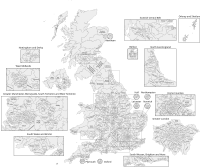| United Kingdom parliamentary constituencies | |
|---|---|
 Constituencies after the 2023 Periodic Review | |
| Category | Electoral district |
| Location | United Kingdom |
| Number | 650 (as of 2023) |
| Government | |
| This article is part of a series on |
| Politics of the United Kingdom |
|---|
 |
|
|
The Parliament of the United Kingdom currently has 650 parliamentary constituencies across the constituent countries (England, Scotland, Wales, and Northern Ireland), each electing a single member of parliament (MP) to the House of Commons by the plurality (first-past-the-post) voting system, ordinarily every five years. Voting last took place in all 650 of those constituencies at the United Kingdom general election on 4 July 2024.
The number of seats rose from 646 to 650 at the 2010 general election after proposals made by the boundary commissions for England, Wales, and Northern Ireland (the Fifth Periodic Review of Westminster constituencies) were adopted through statutory instruments.[1][2][3][4] Constituencies in Scotland remained unchanged, as the Boundary Commission for Scotland had completed a review just before the 2005 general election, which had resulted in a reduction of 13 seats.
Primary legislation provides for the independence of the boundary commissions for each of the four parts of the UK, the number of seats for each of the countries, permissible factors to use in departing from any old boundaries, and a strong duty to consult. The Fifth Review was governed by the Parliamentary Constituencies Act of 1986. Under the Parliamentary Voting System and Constituencies Act 2011, as amended by the Parliamentary Constituencies Act 2020, the number of MPs is now fixed at 650. The Sainte-Laguë formula method is used to form groups of seats split between the four parts of the United Kingdom and the English regions (as defined by the NUTS 1 statistical regions of England).[5]
- ^ "The Parliamentary Constituencies and Assembly Electoral Regions (Wales) Order 2006". www.legislation.gov.uk.
- ^ "The Parliamentary Constituencies (England) Order 2007". www.legislation.gov.uk.
- ^ "The Parliamentary Constituencies (England) (Amendment) Order 2009". www.legislation.gov.uk.
- ^ "The Parliamentary Constituencies (Northern Ireland) Order 2008". www.legislation.gov.uk.
- ^ "A Guide to the 2013 Review" The Boundary Commission for England — retrieved 2012-12-19 Archived 29 October 2012 at the Wayback Machine.

